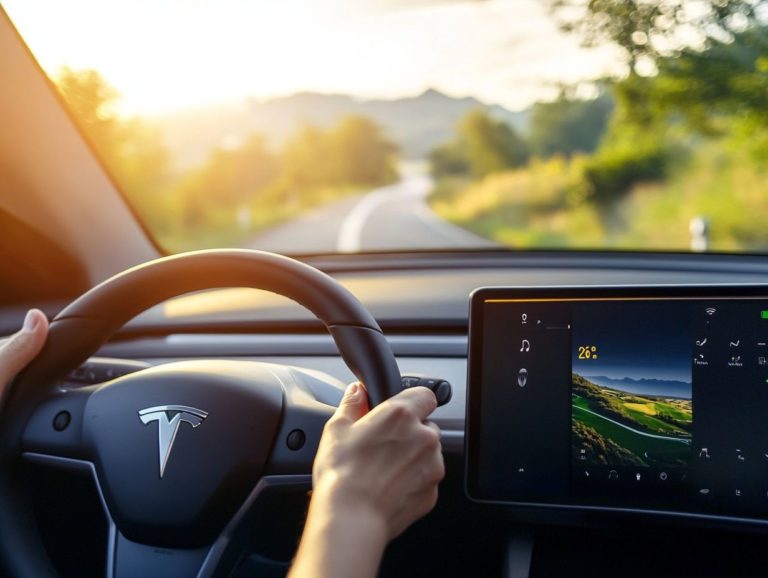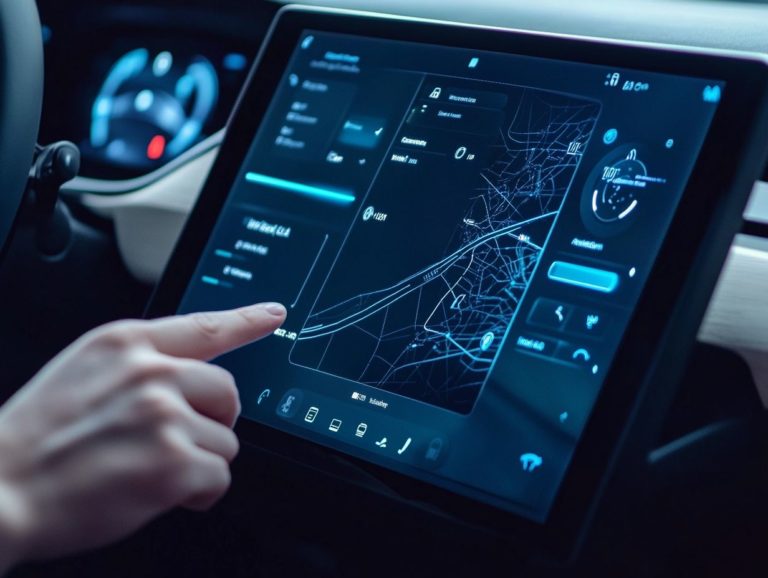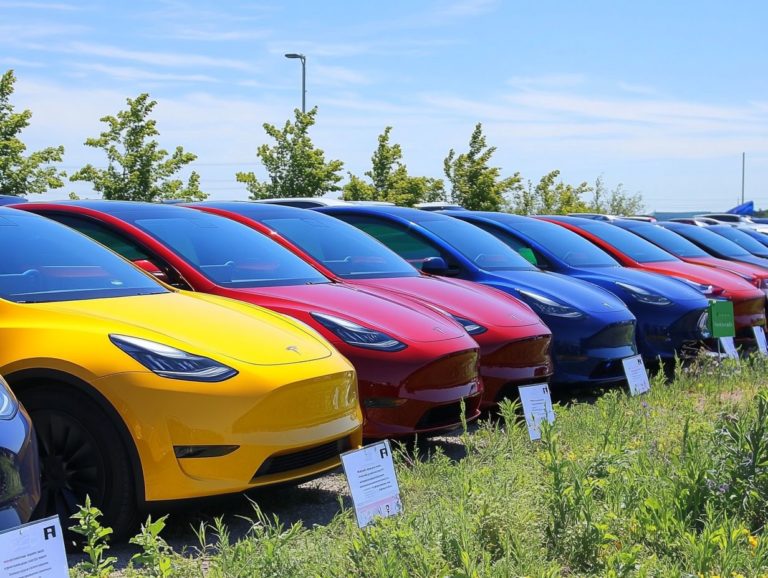39. the rise of autonomous electric vehicles
The rise of autonomous electric vehicles is reshaping the way we move around, seamlessly blending technology with a sustainable future.
This exploration delves into their numerous advantages, highlighting benefits that span environmental sustainability, enhanced safety, and improved efficiency. However, there are challenges to consider; the article will also address the limitations these vehicles face, including technology challenges and regulatory issues.
You ll gain insights into their potential societal and economic impacts, along with current developments and future predictions. Together, you ll navigate this thrilling frontier in transportation.
Contents
Key Takeaways:

Autonomous electric vehicles offer significant environmental benefits, including reduced carbon emissions and improved air quality, making them a crucial component in the fight against climate change.
The implementation of autonomous electric vehicles can greatly improve safety on the roads and increase transportation efficiency. Understanding the role of electric vehicles in smart cities is essential, as technology challenges, regulatory issues, and infrastructure hurdles need to be addressed for widespread adoption.
As technology continues to advance, the future of autonomous electric vehicles is exciting and full of potential! Predictions include increased accessibility and affordability, along with electric vehicle trends to watch in 2024, which may disrupt traditional transportation industries.
Defining Key Terms
In the rapidly evolving world of transport, grasping key terms related to autonomous vehicles is essential for understanding the future of mobility.
Autonomous vehicles are cars that can drive themselves without any human assistance, thanks to advanced technologies like sensors, cameras, and artificial intelligence (the ability of machines to simulate human intelligence).
The Society of Automotive Engineers (SAE) classifies levels of automation from 0 (no automation) to 5 (full automation), with Tesla Autopilot representing level 2 automation and hinting at the potential for level 3 autonomous cars.
It s crucial for you to differentiate these terms to engage in informed discussions about road safety, regulatory changes, and ethical programming.
As technology continues to advance, the ethical dilemmas surrounding these vehicles such as how they make decisions in emergencies and who is liable in accidents become increasingly important.
Following the guidance of the National Highway Traffic Safety Administration (NHTSA), understanding these complexities is vital for shaping a robust legal framework that ensures public safety while also fostering innovation in the automotive industry.
Advantages of Autonomous Electric Vehicles
The rise of autonomous electric vehicles signals a transformative era in urban transportation, with resources like the growth of electric vehicle car-sharing services presenting a wealth of advantages that could redefine your mobility experience.
By minimizing human error and enhancing road safety, these innovations are set to optimize traffic management and provide a compelling alternative to traditional vehicle ownership.
Imagine the possibilities as ride-sharing platforms like Uber and Lyft prepare to incorporate self-driving technology, potentially revolutionizing public health and economic mobility.
With major automakers investing in engineering advancements, the benefits of these vehicles are becoming increasingly clear and enticing!
Stay informed and engaged as we witness the evolution of transportation technology!
Environmental Benefits
Autonomous electric vehicles present a remarkable opportunity for you to contribute to environmental sustainability. They significantly reduce greenhouse gas emissions and enhance energy efficiency through cutting-edge battery technology, making them a key part of the future of electric vehicle design.
As urban areas struggle with pollution and climate change, embracing electric vehicles allows you to help meet the necessary standards for a greener future.
The incorporation of autonomous driving technologies can streamline traffic flow, alleviate congestion, and further reduce carbon footprints in cities. These vehicles can connect seamlessly with renewable energy sources, aligning perfectly with your goal of minimizing environmental impact.
The potential for emissions reduction is impressive. Research shows that widespread adoption could reduce reliance on fossil fuels and lower overall urban air pollution.
How resources are used plays a crucial role in facilitating this green transition. Intelligent infrastructure ensures that charging stations are strategically located, making electric vehicles more accessible to everyone.
Policy initiatives such as tax incentives and subsidies for both manufacturers and consumers can bolster your efforts to embrace this movement. These initiatives encourage you and others to make the switch.
By cultivating a supportive ecosystem, cities can enhance electric vehicle adoption and create a positive ripple effect that benefits public health, contributing to a more sustainable future for all.
Improved Safety and Efficiency
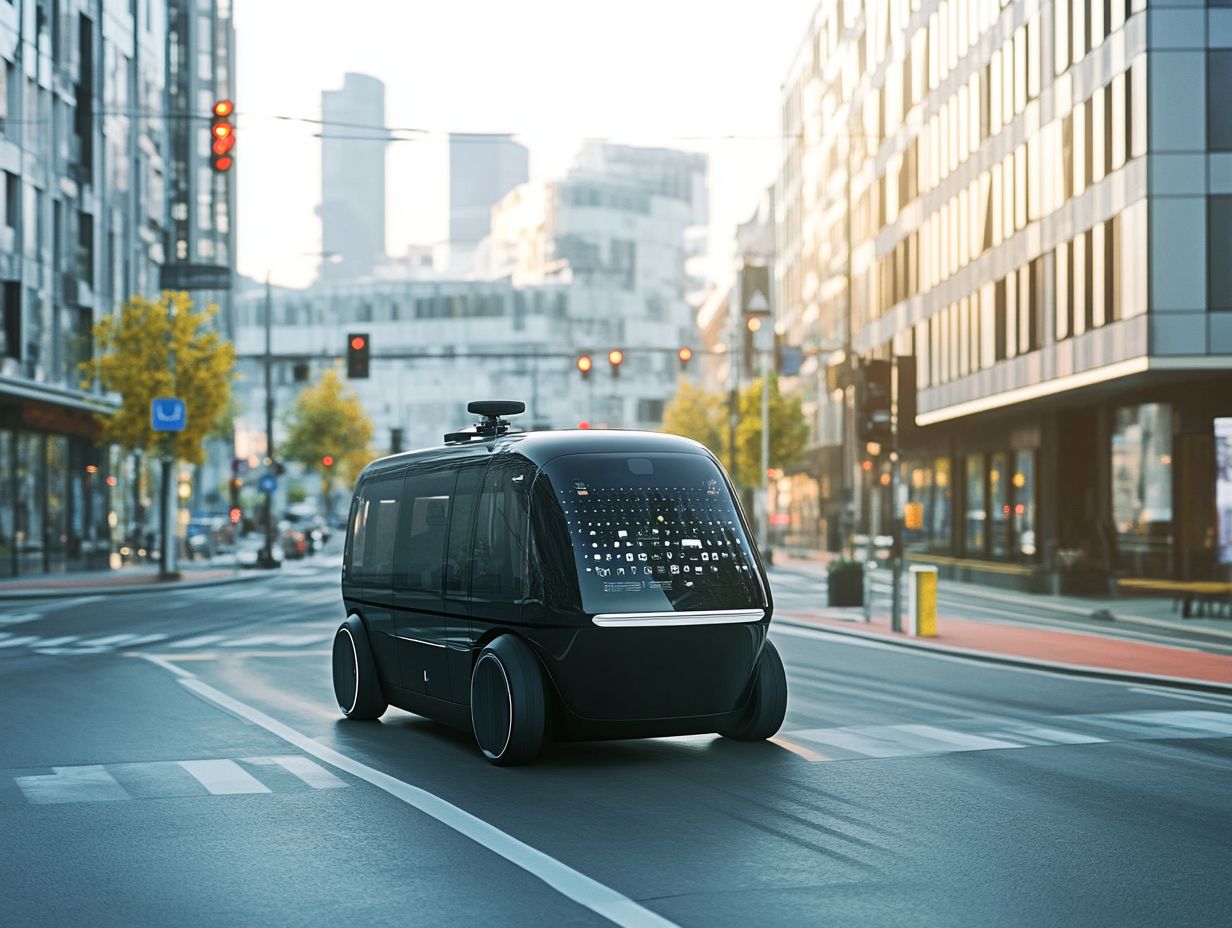
The rise of autonomous vehicles dramatically boosts road safety and driving efficiency by eradicating human error, which is responsible for most traffic accidents.
By following traffic regulations and employing automated driving systems systems that allow cars to drive themselves without human input these vehicles can communicate seamlessly with one another. This enhances traffic management and significantly reduces the chances of collisions.
As they incorporate advanced decision-making algorithms, the prospect of safer urban transportation becomes more achievable. This elevates public safety standards.
These innovations improve collision avoidance and implement sophisticated risk management strategies that assess real-time data to anticipate and counter potential hazards.
By harnessing sensors and machine learning, autonomous vehicles can analyze a multitude of variables. This allows them to adjust their speed or alter their route to minimize risks effectively.
This groundbreaking technology could transform vehicle insurance frameworks, raising intriguing questions about liability in accidents involving self-driving cars. Insurers may need to adapt their models, placing greater emphasis on the vehicle’s software integrity rather than the driver’s actions, ultimately fostering a culture of more responsible driving.
Challenges and Limitations
Despite the appealing promise of autonomous vehicles, several challenges and limitations must be navigated to fully harness their potential within transportation systems.
Technological hurdles abound, particularly when it comes to ensuring the reliability of automated driving systems across diverse driving conditions. This remains a significant obstacle.
On top of that, regulatory challenges arise, including the need for vehicle testing permits and strict adherence to NHTSA guidelines. This complicates the journey toward widespread adoption.
Furthermore, pressing concerns surrounding cybersecurity must not be overlooked. The potential for cyberattacks on these systems raises critical questions about public safety and effective risk management.
Technological Hurdles
Technological hurdles are a big obstacle to the widespread adoption of autonomous vehicles, especially concerning the reliability of computer systems that control cars without human input across various conditions.
Challenges like bad weather, busy city streets, and unexpected road obstacles require continuous engineering improvements to ensure safety.
During transitions, having a safety driver may still be necessary as advanced algorithms and machine learning evolve to handle all scenarios on their own.
These challenges highlight the need for strong sensor technologies that can accurately interpret the driving environment, even in heavy rain and fog.
Artificial intelligence plays a crucial role in processing large amounts of data to make real-time decisions, but it needs constant updates to integrate new learnings and tackle rare situations.
As the industry progresses, focusing on reliability is crucial, serving as a foundational element for building consumer trust and gaining regulatory approval.
Achieving seamless integration of hardware and software solutions will greatly influence how quickly the public embraces this transformative mode of transportation.
Regulatory and Infrastructure Challenges
The rules for autonomous vehicles are changing fast, presenting significant challenges regarding legal frameworks and infrastructure development. As you follow NHTSA guidelines, you’ll navigate a complex web of regulations that vary across regions and countries, such as California, Germany, and China.
The existing infrastructure might not be equipped to support the advancements needed, potentially delaying the rollout and adoption of autonomous driving systems.
In these diverse regions, government involvement plays a pivotal role in shaping policies that can either speed up or slow down your progress. For example, inconsistent laws about liability insurance and safety certification can create uncertainty for both manufacturers and consumers.
To ensure a smooth integration of autonomous vehicles into public spaces, investing in infrastructure like dedicated lanes and smart traffic management systems is critical.
It s crucial to foster collaboration among stakeholders now to overcome these regulatory challenges and build the framework necessary for a future where autonomous technology can thrive safely and efficiently.
The Future of Autonomous Electric Vehicles
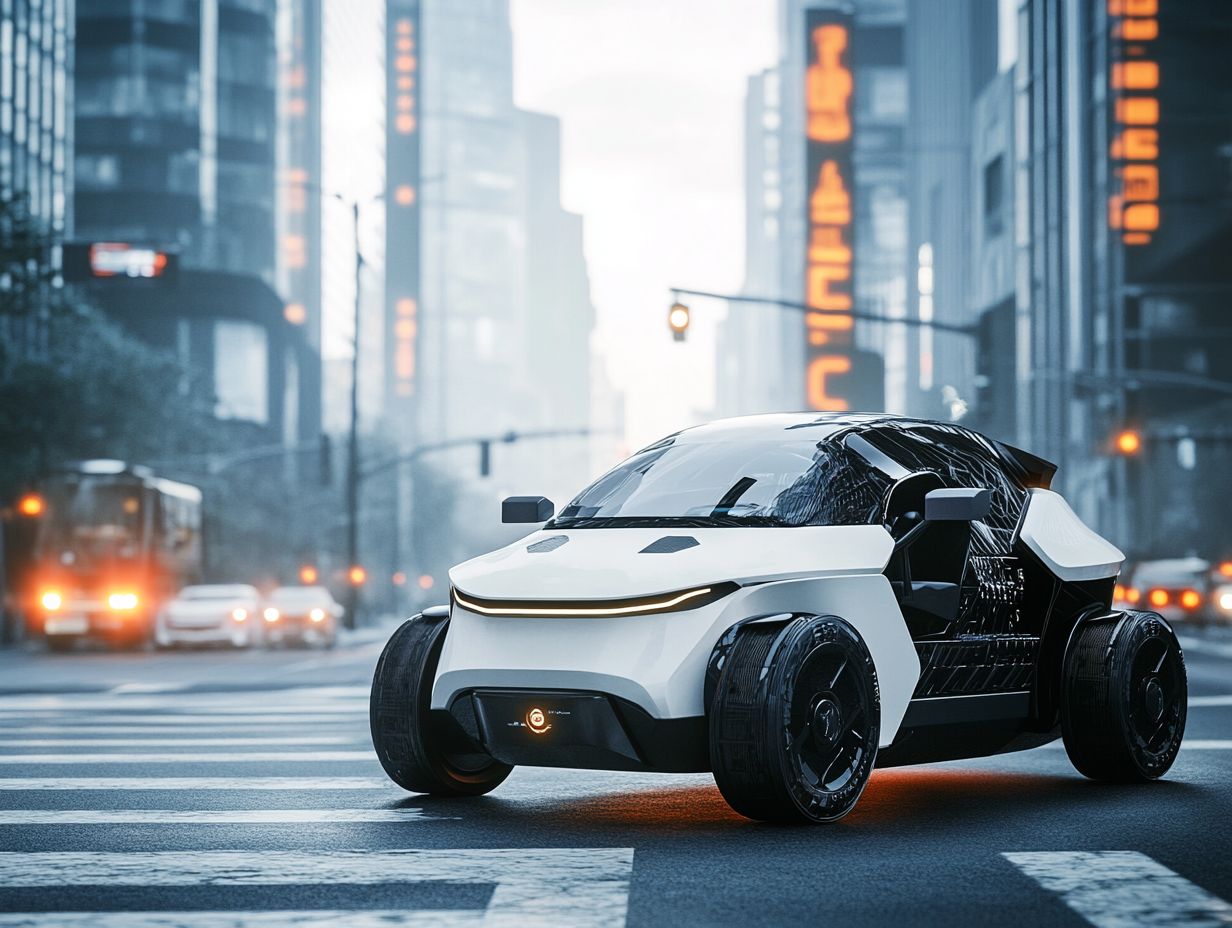
The future of autonomous electric vehicles is about to explode with growth, driven by technological advancements and shifting consumer preferences for modern mobility solutions.
Major automakers are channeling significant resources into research and development, eager to unlock the full potential of autonomous vehicles while aligning their strategies with global trends in sustainability and urbanization.
As urban transportation continues to evolve, you can expect that vehicle insurance models must also adapt, addressing the unique risks and challenges these groundbreaking solutions present.
Current Developments and Predictions
Current developments in autonomous vehicles are moving at an impressive pace, with leaders like Tesla and Waymo pushing innovative engineering and practical applications. It’s not just about cutting-edge technology; it’s also about you, the consumer, and how you understand and accept these changes.
Companies like Uber and Lyft are actively exploring how to seamlessly integrate autonomous driving systems into their ride-sharing platforms. The next decade could very well see autonomous vehicles becoming a staple in urban transportation.
As these major players push the envelope, exciting partnerships are emerging. For example, Ford’s collaboration with Argo AI and General Motors’ investment in Cruise Automation are focused on enhancing not only the software but also the safety and efficiency of autonomous systems.
Pilot programs are being rolled out in cities worldwide, providing real-world testing scenarios that are crucial for refining the technology.
Consumer trends indicate a growing appetite for eco-friendly and efficient transportation solutions, suggesting that your transition to autonomous vehicles could be smoother than you might expect.
Industry experts forecast that by 2030, a significant percentage of new vehicles sold will feature some level of autonomy, revolutionizing mobility in ways you may not have imagined.
Impact on Society and Economy
The rise of autonomous vehicles is reshaping both society and the economy, and alongside this trend is the rise of electric vehicle startups that are transforming traditional ideas about economic mobility and public health.
As services that let you use a car without owning it become more common, the need for personal vehicle ownership may decrease. This shift can change how resources are allocated and how urban planning strategies are developed.
Embracing self-driving technology can improve public health outcomes by reducing accident rates and enhancing transportation access for underserved communities.
Potential Changes and Disruptions
Autonomous vehicles are set to revolutionize how we think about transportation. This includes significant changes in vehicle ownership and the growth of ride-sharing platforms.
As self-driving technology becomes widespread, ethical dilemmas will arise regarding liability and the role of safety drivers. This situation calls for a reassessment of driving laws and regulations.
This shift may change how you view urban transportation and mobility overall.
As these vehicles become more common, you might notice a change in consumer behavior. People may prefer convenience over ownership, gravitating towards subscription-based models or shared services.
This transition also presents critical regulatory challenges, particularly regarding safety standards and data privacy. The use of algorithms in transportation management could expose cybersecurity vulnerabilities that must be addressed.
Ethical programming is essential, as developers need to tackle biases in artificial intelligence systems to ensure fair access and equitable solutions for everyone.
Ultimately, the future of transportation depends on the collaboration of policymakers, tech companies, and communities as they navigate these complex changes together.
Frequently Asked Questions

1. What are autonomous electric vehicles (AEVs)?
Autonomous electric vehicles, or self-driving electric cars, are vehicles that can operate without human input. They utilize sensors, cameras, and artificial intelligence to navigate and make driving decisions.
2. How are AEVs different from traditional electric vehicles?
AEVs differ from traditional electric vehicles in that they do not require a human driver. They have advanced technology like lidar and radar, which helps them detect and avoid obstacles.
3. What is driving the rise of AEVs?
The rise of AEVs is driven by advancements in technology and the growing demand for efficient transportation. Companies are heavily investing in research and development to make AEVs a viable and safe option.
4. Are AEVs safe?
While the technology is still developing, many experts believe AEVs could be safer than traditional vehicles. They eliminate human error, responsible for most car accidents, and include advanced safety features.
5. Will AEVs replace traditional vehicles?
It is unlikely that AEVs will fully replace traditional vehicles soon. However, as technology improves and becomes more affordable, AEVs are expected to become a more common transportation option.
6. What are some potential benefits of widespread use of AEVs?
The widespread use of AEVs can lead to numerous benefits such as reduced traffic congestion, improved air quality, and increased road safety. They can also make transportation more accessible for individuals who cannot drive traditional vehicles.
If you want to learn more about autonomous vehicles, explore additional resources or discussions on this exciting topic!

